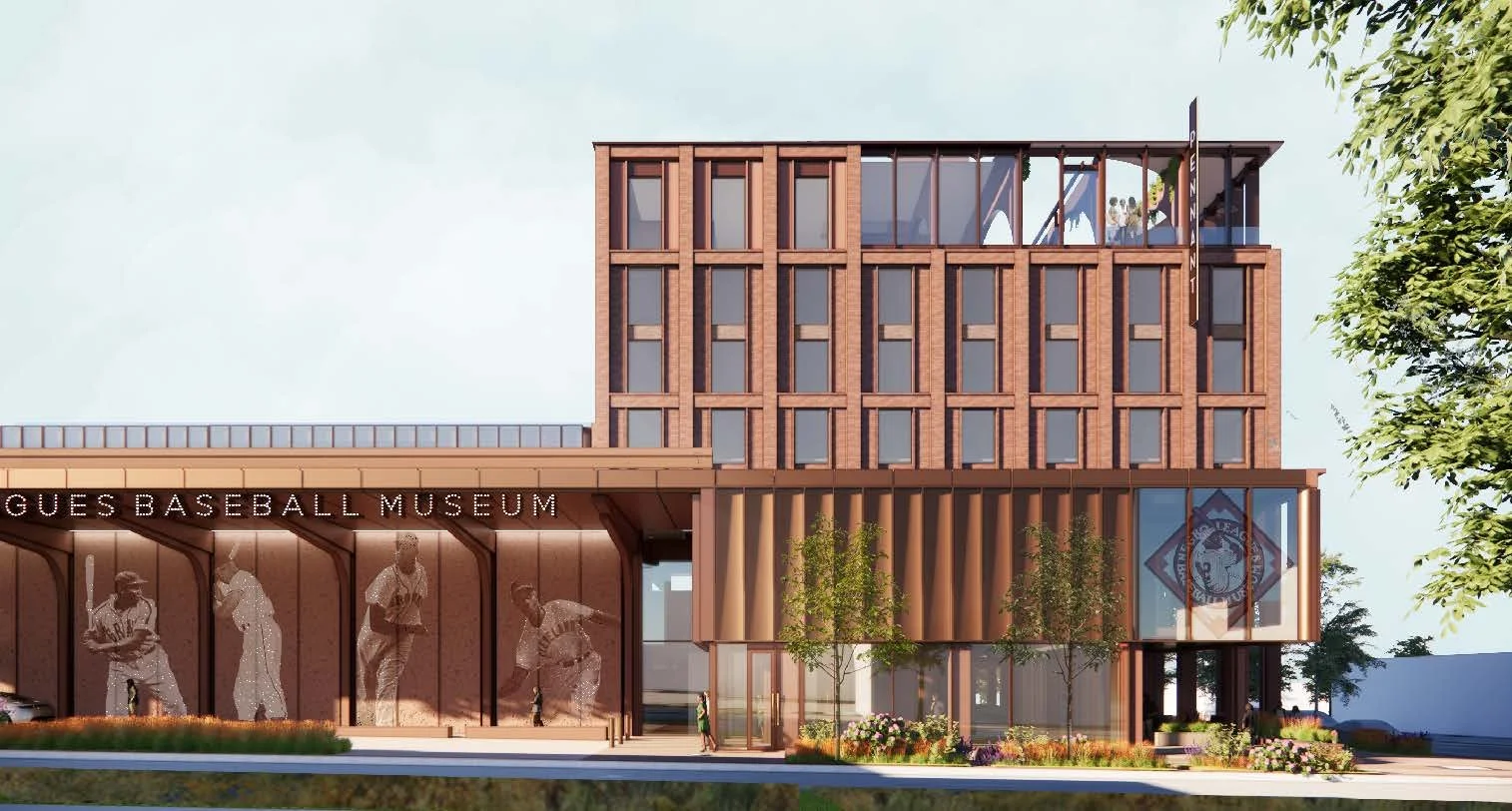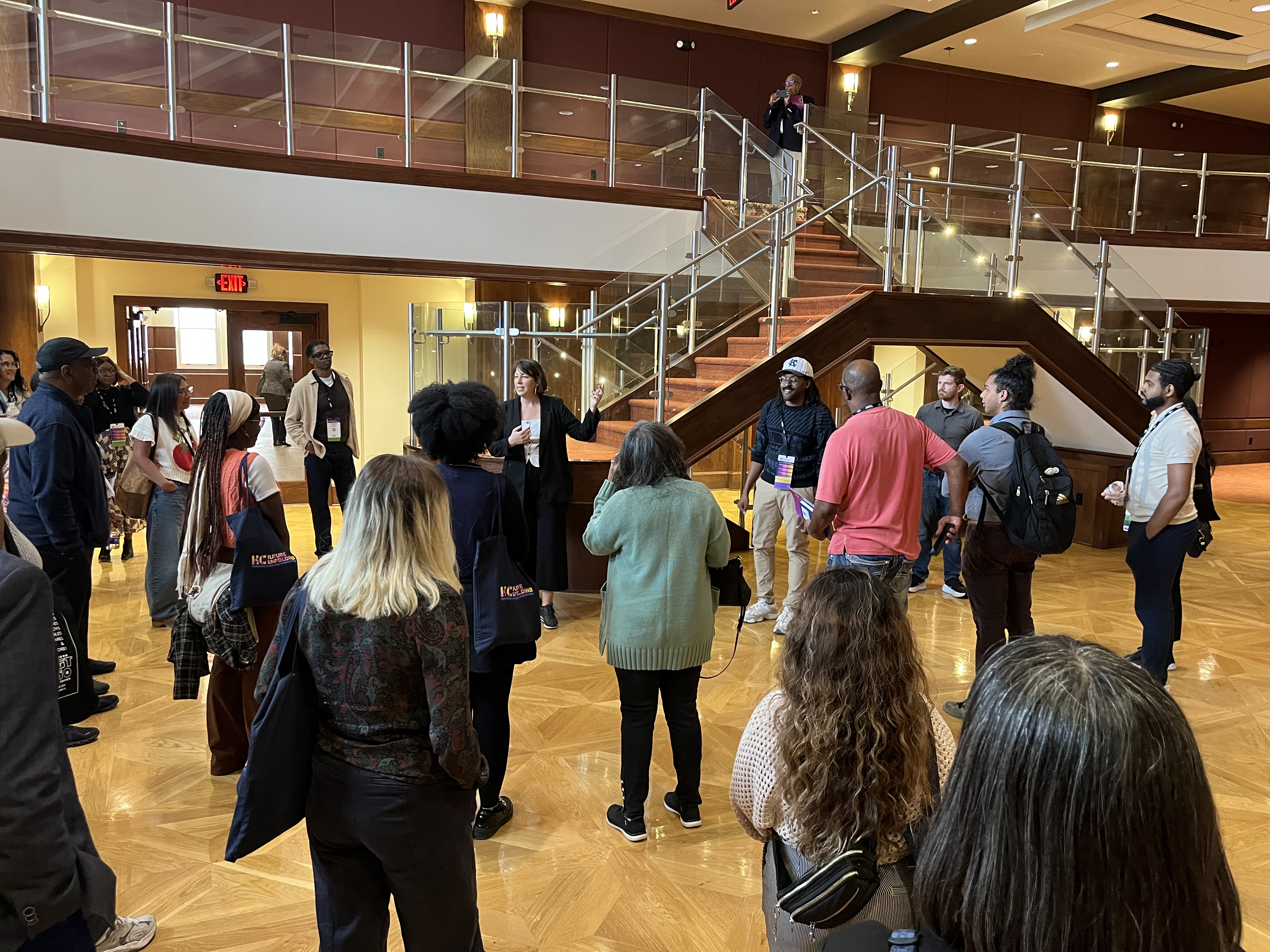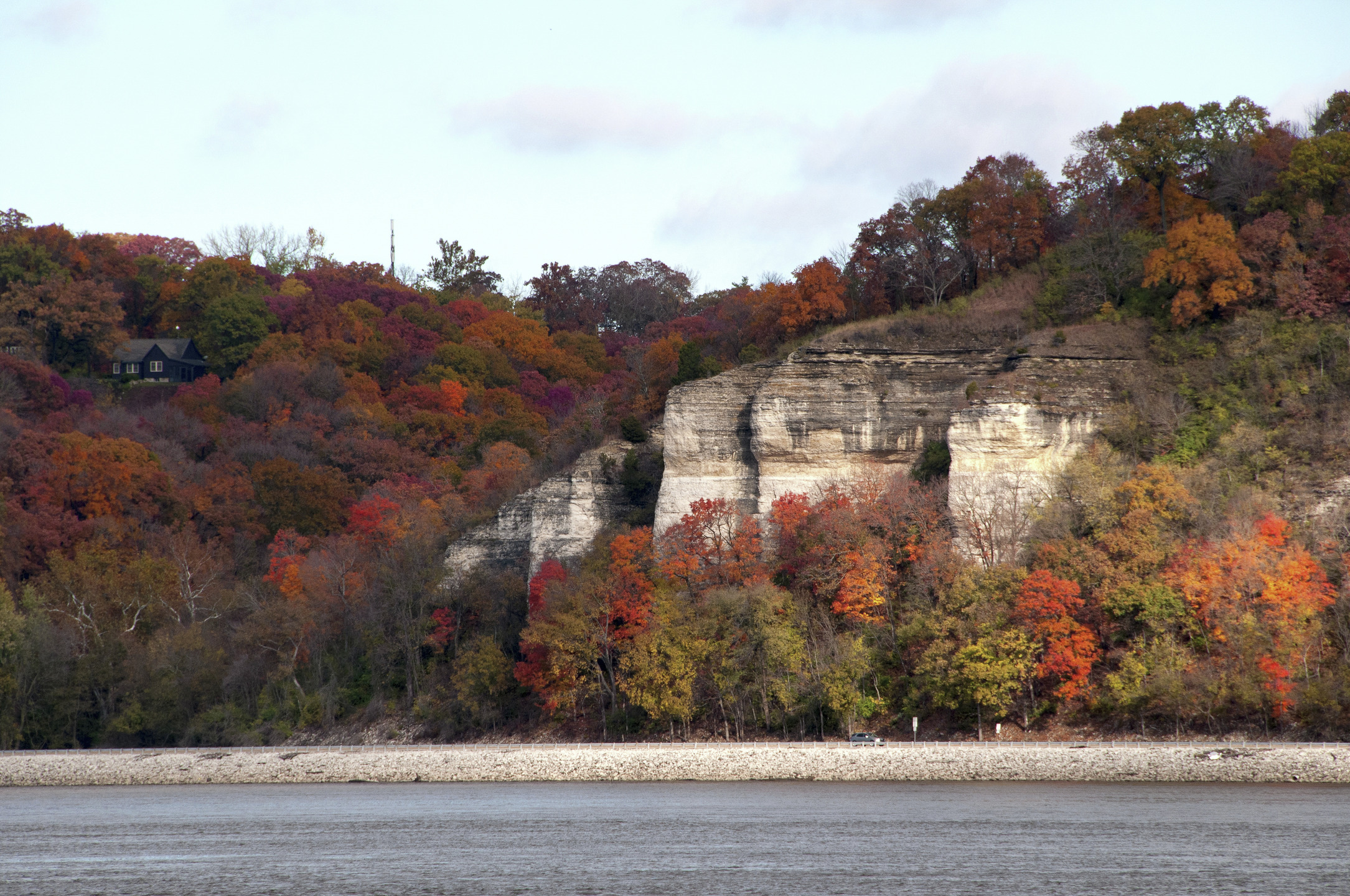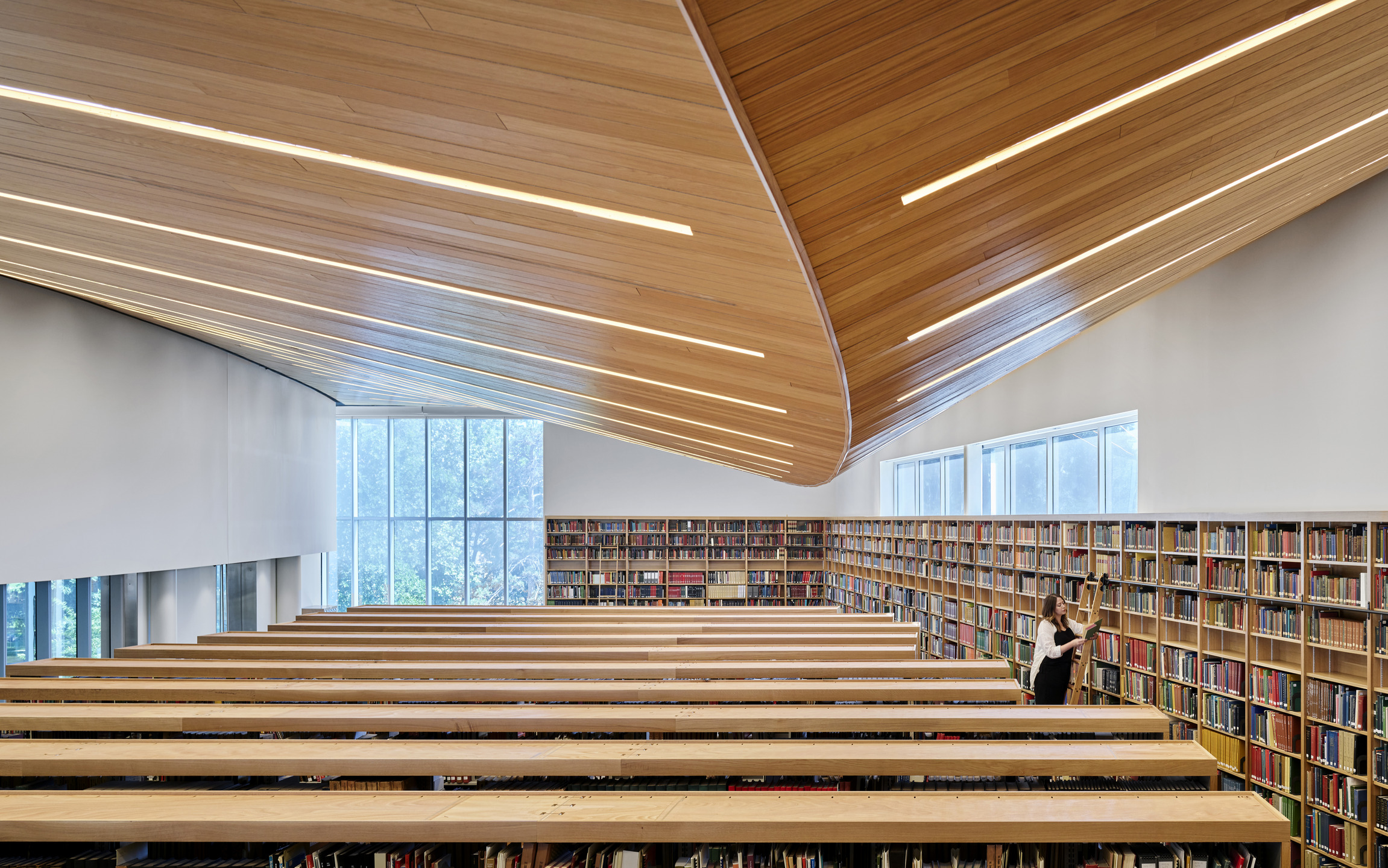

Principal designer Emily Harrold embodies the “multi” in our name. As an architect, interior designer, and civic partner, she honors stakeholders’ diverse needs while storytelling across scales, from master planning to the finest design detail.

Harrold currently leads design for the Negro Leagues Baseball Museum and Hotel development in Kansas City’s 18th and Vine District, a historic Black neighborhood revered for its distinct impact on American culture.
An advocate for exploration, deep listening, and collaboration, she pairs community engagement with thoughtful design intent to preserve legacies, evoke memories, and define new possibilities for the places she serves.
We spoke with Harrold about the Negro Leagues Baseball Museum and Hotel project and her “community-generalist” approach to practicing in our Kansas City studio.

Emily Harrold: I am the principal lead and designer on the project. I’ve been a part of the project from the master planning concept, which is a whole block, to what I’m focused on now, which is just the hotel and museum component.
EH: I was especially excited by the impetus of Grayson Capital, which had been awarded the development of a parking lot in the historic 18th and Vine neighborhood, which is where Black economic development was really strong in the heyday of baseball and jazz. The city had started to propose a housing piece in that neighborhood. Simultaneously, the museum had been awarded the city’s most historic archive, the YMCA on The Paseo. This YMCA is where the Negro Leagues were actually founded. The museum began a study to expand and move its space a block away, next to the historic YMCA.
This is where Multistudio came in. Grayson Capital and Kansas City had been working with two separate architects, but their sites abut each other. They were having conversations about combining their efforts in this area and came up with a new program: a museum expansion, a museum-themed hotel district, a parking garage, and housing. Multistudio was able to partner with those early architects to propose a blended master planning team. The idea of impacting a whole city block next to this historic district, which has been well maintained, was an incredible opportunity for Kansas City and this district in particular.

EH: I’m adept at strong community engagement and navigating complicated leadership structures. What excites me is trying to help a group of people to realize a unified vision, ensuring that all constituents feel heard and that their vision is moving forward. One of the key things I do on every project is align the vision statement.

This vision emerges through listening and having one-on-one conversations with different parties, then in a collective group, repeating back what I heard and providing feedback. Everyone is unified on the impact of Negro Leagues baseball on our culture and how important it is. Everyone is supportive of this being the new visionary gateway for the district.
EH: East Kansas City was historically a redlined Black community with a strong economic culture and national recognition for contributions to baseball, jazz, and barbecue. Kansas City has invested money and effort in this area. For Multistudio, it’s about honoring the legacy, but also thinking about progression and moving forward. We’ve had to look at context, physical makeup, and scale. It’s a brick, very walkable community. We don’t want to overwhelm the neighborhood, but complement it.
We also have great visibility from the highway. We’ve been thinking about the project as a beacon, a visual marker for the site, connecting it to the broader downtown Kansas City area. We sit catty-corner to a historic 18th and Vine neon sign. Our answer on the opposing corner, how it engages the community and bridges the two, is a big piece of this project. We’ve referred to this as home plate: where the hotel and museum meet, where things start and end, like in a baseball game. The relation to the context, materiality, and stories we’re relating to has been important, as are the historical stories and players, who were heroes for our nation.
EH: The housing piece is in partnership with DRAW Architecture. We teamed up with them on the master plan. We are carrying forward the hotel and museum; they are working on the housing piece. It’s a four-story complex. It will have 400 stalls of parking attached to it, which is a district-wide shared amenity between the housing, the hotel, the museum, and the district.

EH: One of the people on our community engagement team, Pat Jordan, has been doing tremendous research about how unaffordable Kansas City is for our working class. She’s working with the community to introduce market-rate affordable housing data. When I say affordable, they’re targeting $650 per month, which, compared to the region, cuts market rates in half. This area, known for public housing, is transitioning into more urban, walkable apartment housing. The neighborhood is trying to blend affordable and market-rate to create the vibrancy that was there: the business owners, Madam C.J. Walker had a store here, along with the original Black-owned Street Hotel. Bob Kendrick, the museum’s president, says the story we are telling here is about economic development, the vibrancy of community, and what baseball contributed and sparked.
EH: It’s important to recognize that this district is known for Black economic success, and an entrepreneurial culture. The housing component is also picking up on those aspects. It’s broader and aspirational: a new arts complex nearby to bring artists and creatives into the community, along with active storefronts along vibrant, walkable streets. It’s all intertwined, tied to baseball’s unification story. There’s an Urban Youth Academy adjacent to the project. It’s all embedded.
One of my favorite stories Bob Kendrick tells is about Sunday ball. Negro Leagues baseball was traditionally played on Sundays for a working-class community. During the week, baseball didn’t exist, so they had Sunday ball. It was common to leave church dressed to the nines to attend games on Sunday.
And culturally, if you think about it, there was church in the morning, baseball in the afternoon, and jazz in the evening in that district. Neighborhoods are most vibrant when they have activity from day to night. If you want to see a place thrive, you need people working during the day and going to lunch; at night, you need people walking to local shops; and you need people living within the community.

EH: Sports are interesting because they draw everyone. It’s different from art. Art doesn’t draw everyone, but sports draw in all ages and ethnicities. It’s a great opportunity to bring different cultures together. The museum itself is talking about resilience and triumph and celebrating the heroism of baseball, especially Negro League players. We’re all trying to build upon that. This project will welcome people to a hotel east of Troost Avenue. There’s not a high-end hotel east of Troost in Kansas City. We have an opportunity to bring a collective group of people from all over the world to a national baseball museum that is talking about a minority population and celebrating that triumph — the triumph of perseverance.
EH: The architecture picks up on nostalgic notions of baseball stadiums, such as arches and colonnades. We also thought about the clay on an infield. At the beginning of the game, it’s pristine and perfect, but by the end, it’s all over everyone; it’s been played upon, disturbed. We selected a brick for the hotel that is the color of that clay. It’s not perfect. It has imperfections.
We’re intentionally sprinkling little things like that throughout the project to tell a baseball story. In the sidewalk, every 90 feet, the length of a base path, you’ll discover unexpected details to create immersion, while the physical characteristics of the building echo aspects of baseball. There’s a spot in the museum with chicken wire, dividing the spectator from the player. We also have glass that evokes this separation and a custom metal panel filleted like the shape of baseball bats. We also thought about the image of bats lined up in dugouts. We’re subtly replicating that in the architecture, with bats marching down the building. I mentioned arches and colonnades for arrival. We’ve talked about arrival a lot. You have the museum visitor, private events, people working in the YMCA, hotel guests, someone grabbing a drink at the hotel, and ensuring that each experience is thought of, memorable and a key part of the discussion.
EH: I’ll tell a little story. I became an architect because when I was 14 or 15, I went to the library a lot and rented VHS documentaries. I rented one about Frank Lloyd Wright and Fallingwater. The idea that you could integrate something like a waterfall so seamlessly with a place made me want to become an architect.
It wasn’t that I wanted to design a building over a waterfall (which I would totally do), but that you come to a place with something special, a story you wanted to tell and celebrate. You start there, at a high level, with whatever that special thing is — and there is always something.
On our State Historical Society of Missouri project, we thought about the confluence of the Missouri and Mississippi Rivers, which were the impetus for the region and economy. We were inspired by the river bluffs and rippling water. You start with the bigger picture, like baseball, in this instance, which is a spectacle. And there are many layers of engagement and experience overlaid with history and place.


Then you dive deeper into that idea. I love the subtleties you can immerse in a project. It’s creative. It gets people engaged. It creates memories and impact.
EH: I certainly embrace the “throw it all at the board and see what sticks.” I think that approach excites us as a collective. I help create ideas behind a building, but I don’t live with them day to day like the client does. Ultimately, the work has to be meaningful, impactful, and useful for them to be a success. A design can’t just be pretty pictures and an abstraction.
Ideation can be messy. I live in ambiguity a lot, and some people have a hard time living in that ambiguity. At the beginning of a project, you can’t define what it looks like. You define an essence of what you want it to feel like. If you can get everyone to buy into an essence, then you can sprinkle in how that could manifest as ideas. And these are not just the ideas that you’re partial to; all ideas are on the table.
Once you start talking about stacking the program or materials, the details you’ve brainstormed could become part of the project. It’s important to be iterative and show options. Our role is visual storytelling in a way that’s comprehensible to people not in our industry.

I love working on a team that collaborates from beginning to end as much as possible. The most successful projects I’ve been part of have internal, consultant, and client teams who all feel invested. That’s important. Over time, I’ve gotten better at helping facilitate collaboration. You have to facilitate in a way that allows people to be vulnerable and really talk about how they feel. I’m trying to pull that emotive piece out.
Of course, the building has to work and meet code, but the emotion is intangible and challenging. It takes time. We’ve been working for 18 months already with a whole group of different people. It will be at least two and a half years before anyone steps through a door.
EH: It’s a Marriott Tribute hotel. The Tribute brand thrives on each being a unique story of its place. There will be an immersion of baseball into the hotel. The whole sequence is connected. There’s a museum entry, and you exit the store connected to the hotel lobby. The hotel has a bar and restaurant. They’ve been great about partnering on who owns what components and how they complement each other. The historic YMCA is an event space, and the hotel will support events in the YMCA and in the Gem Theater, which has been reinvigorated.
We’re going to have a pretty badass bar on the seventh level with an amazing view of the 18th and Vine District, the Crossroads, and downtown KC, all different neighborhood scales. First and foremost, anchoring the corner and creating an inviting place for hotel guests and the neighborhood, from coffee to cocktails to dinner, is important.
We’re also looking at whether a Major League team could come and stay here. There are three or four baseball fields at the Urban Youth Academy. Could teams and families stay if they’re attending a tournament? The hotel is looking at the broader context and how to plug in and bring pieces together.
EH: This project is represented by a unified group of people, all of whom had ideas. I mentioned at the beginning that the YMCA was going to be renovated; the Museum needed to expand, and the City had an underutilized parking lot, and brought in a developer. The developer’s initial response was housing; then they talked to neighbors, understood other projects, and wanted to work collectively.
This project reminds me that you may come into something with an original idea, yet you must always have an awareness of bringing others from the community together. In October, the National Organization of Minority Architects will be in Kansas City. I’m hosting a panel where the developer, the Museum president, and the community activist who started by saving the Gem Theater talk about what this project means, how they came together, and how it came to fruition. If I step back, that’s one of the most impactful things any community, city, or neighborhood could learn: how this project is even a possibility. It’s hard. It takes time and compromise. But in the long run, the impact will be tremendous because of patience, perseverance, and working together.
EH: You mentioned that not every project will have a rich story. I have to say, I fundamentally disagree. Every project, regardless of scale, regardless of place, has an opportunity. I truly believe that. In a generalist firm, that’s a critical idea. Yes, I may have worked on a school, a church, or something else, but it’s not about the typology. It’s about the spark of imagination and ideas, regardless of the project. I tell our staff and people who work with me: you can find a stair detail and make it inspiring. There’s something you can do that’s inspiring.
All the repeats of prototypes: I call that the homogenization of America. I’m honestly anti-prototype when it comes to architecture and making cities. If you ask me to make a prototype over and over, how will that inspire me to make it better? I don’t know that it will. If we’re dropping in buildings regardless of site and community impact and input, then where’s the meaning? We make a case for not just generalism, but for community-based generalism.

EH: Multistudio understands the importance of being a place-based firm. We are deeply embedded in the cities we work in. We look at projects through the lens of design, memory, and place. And the ability to work on different projects and being nimble allows us to consider new possibilities for places where people want to be — and that requires exploration.
I liken this to recess. At recess, as a kid, you had the opportunity to explore. You went from a structured “sit at your desk” environment to recess, everyone’s favorite. The reason it was my favorite was that I could sit on a swing by myself one day and think, play foursquare with friends on another, and run around wildly on another. There wasn’t a scripted thing you had to do.
There’s a distinction. And it’s more fun for everyone. I’ve developed client relationships that are like friendships. You want to have a drink and dinner with these people because you relate on a communal level, versus a teacher telling you what to do, following steps, and giving them the exact expected result.
EH: If you’re listening, it’s not about you. I think that’s a key element. Who doesn’t want to be heard? Who doesn’t want to say to themselves, “I was listened to, and I’m proud of this place we made together”?
Learn about new projects from our Kansas City studio here or by following Emily Harrold on LinkedIn.
You can learn about the Negro Leagues Baseball Museum by visiting www.nlbm.com. To learn about Pat Jordan, president of Pat Jordan & Associates and founder of iSTEAMkc & Community Cares KC you can find her on LinkedIn here.
